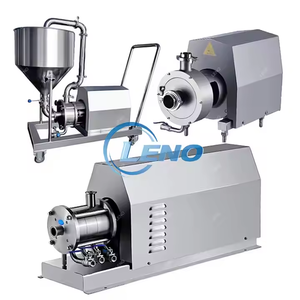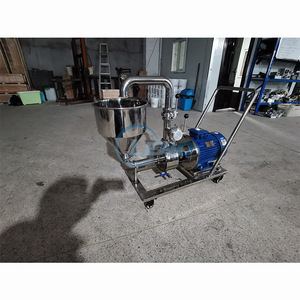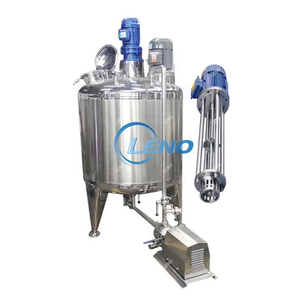(40 products available)
























































































































































































Homogenization is an important process in various food and pharmaceutical industries. An IKA homogenizer is designed to perform this specific task efficiently. The IKA homogenizer can be divided into the following six types based on how it homogenizes the sample.
Wet Milling Homogenizers
The IKA wet mill homogenizer is used to process liquids and semi-solid materials. It usually has a gentle start to avoid introducing air into the sample. To ensure uniform results, it may go through the system multiple times. Final products may have a smooth texture and improved stability.
High-Acapacity Wet Mill Homogenizers
Wet milling homogenizers with a high capacity can handle large quantities of biomass or other materials in one go. This reduces the time spent processing samples. These high -capacity homogenizers work the same as standard wet mill homogenizers. Products may have a uniform consistency, excellent emulsion stability, and a shelf life that complies with industry standards.
Dry Milling Homogenizers
The IKA dry milling homogenizer is used to process dry materials. It works differently than wet milling models, as it can pulverize substances like glass, ceramics, and other calciferous materials to a particle size of less than 1mm. A homogenizer that dry mills has a strong motor that can process even the hardest materials. Using one of these devices can create fine powders, save time, and have a longer operational life.
High-Acapacity Dry Mill Homogenizers
Milling dry materials in large quantities is even more efficient with high-capacity models. They reduce processing time and are developed for heavy-duty applications in various industries.
Modified Homogenizers
A modified homogenizer has different characteristics. It may have custom-designed rotors and stators to achieve a certain grade of milling or homogenizing. Some may also have a special coating on the milling element to process corrosive fluids.
Specifications of an ika GmbH homogenizer vary depending on the model. Details like the size, working capacity and power are model specific. Here are some general model specifications;
Aside from these, there are other ways to differentiate between models. For instance, some models are made with a stainless-steel housing material, whereas others use aluminum. More distinguishing characteristics can be found in the product manual. Users should always refer to the manufacturer’s manual to understand more about the device's features.
When considering how to maintain an ika homogenizer, the most crucial parts to think about are the pump and cutting blades. If they are not cared for, they can become damaged beyond repair. They can also wear out quickly and need to be replaced more often than required. The best way to ensure that these parts stay intact and functional for years is to clean and sterilize them regularly. This is important especially when they are used on biological or food substances.
Proper cleaning and sterilization methods are usually provided in the user manuals. Nevertheless, some general methods are applicable to almost all homogenizer parts. Before cleaning, it is important to note that some parts are not dishwasher-safe and must not be immersed in water. These parts usually have electronic components to ensure they are not wet. Typical parts that users can clean include:
To clean the housing, which is usually made from a stainless steel material, users can use a moist towel or cloth to wipe off any liquid spills. Alternatively, they can make use of a cleaning solution to eliminate any stains. When cleaning the cutter blades, users should carefully detach them before wiping them clean thoroughly. They should also ensure that they are dry before re-assembling them back into the device. Users can clean the base/stand with a damp cloth. To avoid getting it wet, they should only clean with a damp cloth and not submerge any part in water.
As mentioned earlier, instructions may vary depending on the model. Manufacturers provide detailed cleaning and sterilization tips so users don’t damage the devices.
Food and beverage industry
Homogenizers play an important role in the food and beverage industry. They are commonly used in the production of milk, dairy products, juices, sauces, and other food items. By homogenizing these products, homogenizers ensure uniform distribution of fat globules, maintain product consistency, improve mouthfeel, and extend shelf life.
Pharmaceutical and biotechnology industry
In the pharmaceutical and biotechnology industry, homogenizers are used for cell disruption, enzyme and DNA extraction, and the preparation of vaccines and antibodies, among other applications. They help break open cells to release intracellular components, improving the efficiency of the extraction process.
Cosmetics and personal care industry
Homogenizers are widely used in the cosmetics and personal care industry to process emulsions, suspensions, creams, lotions, and other products. They ensure uniform distribution of particles and active ingredients, enhance product stability, improve texture and sensory experiences, and meet quality standards.
Chemical industry
In the chemical industry, homogenizers are used for the dispersion and emulsification of various chemical products, such as coatings, paints, inks, adhesives, and chemical additives. They improve the stability and consistency of these products by breaking down particles and promoting uniform distribution.
Research and laboratory applications
Homogenizers are widely used in research and laboratory settings for sample preparation, cell disruption, tissue homogenization, and the establishment of model systems, among other applications. They assist in the extraction of biological molecules, the study of cellular processes, and the development of scientific research methodologies.
Before investing in an IKA homogenizer, buyers should consider the following:
Effective working volume
Knowing the effective working volume will help buyers decide what type of sample the homogenizer will work with.
Sample size and type
Some homogenizers work well with water-based products, while others work with high-viscosity liquids. Also, customers' sample sizes may differ, so choose a homogenizer that works with specified sample sizes and types.
Throughput demands
This relates to how many samples the homogenizer will process in a set time. A high-throughput homogenizer will be ideal for large sample volumes.
Desired end product
A well-distributed sample with a high percentage of cell lysis is the aim when using a homogenizer. The IKA homogenizer's ability to achieve this should be considered when selecting the device.
Maintenance requirements
Some devices have a long upkeep based on constant blade replacement. Others have low maintenance and are easier to clean and sterilize than others.
Q1: What are the factors affecting the performance of an IKA homogenizer?
A1: Several factors can affect the performance of an IKA homogenizer. Product temperature, the number of passes, the feeding pressure, and the size of the homogenizer pump can all affect the final homogenous result of a product. Working with a cooled product can improve homogenization and yield better results.
Q2: Do IKA lab homogenizers have filters?
A2: Yes, IKA lab homogenizers do have filters. Typical filters used with IKA homogenizers include a pleated filter and a DPZ filter. The homogenizer filters trap debris that can damage the pump or cause unwanted while filtering tissue.
Q3: Can an IKA homogenizer be used with a tube?
A3: Yes, an IKA homogenizer can be used with a tube. Depending on the diameter of the tube, it may be necessary to use a homogenizer adapter to secure the tube in place. Be sure to choose the right size for a homogenous solution.
Q4: How do buyers know if they need a high-shear or low-shear IKA homogenizer?
A4: Buyers need to consider the small-scale power and viscosity they want to emulsify while considering the specific application of the IKA homogenizer. A high-shear IKA homogenizer is generally used for emulsifying low-shear products, while a low-shear is suitable for thick or viscous products.